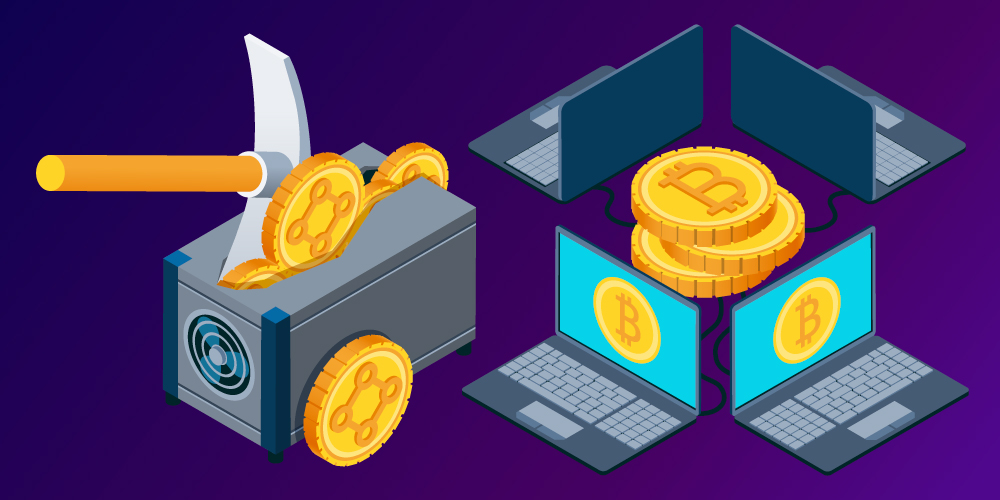Regardless of whether you are a beginner the world of cryptocurrencies or have been in the industry for some time, it will be useful for you to get acquainted with the basic concepts of mining and find out which cryptocurrencies are best to mine this year.
Ways to master the crypto space
When digital currency became mainstream in 2017, people from all over the world began to explore different ways to make profit in this young and booming industry. Naturally, the first wave of cryptocurrency enthusiasts chose speculation as a mechanism for making money. However, the wild volatility of this market has left many of them empty-handed.
Others decided to start mining cryptocurrencies. In other words, by adding new blocks to the chain and receiving rewards in digital currency. Surely, adding blocks to the chain is not an easy process. And if your skills in this matter are zero, then the information you are going to read may actually help you. Ready?
Getting started with cryptocurrency mining
To understand the mining process, it is important to know the basics of cryptocurrencies. Digital currencies rely on cryptography to protect transactions, as well as to manage the creation of new cryptocurrency units.
Crypto assets run on various blockchains-public distributed registries programmed to record almost everything of value, including financial transactions. Each transaction is a piece of data stored in a specific block in the block chain.
Cryptocurrencies are created during the mining process. The process consists of miners solving complex computational tasks to release blocks, and then receiving a reward in the form of new coins. Instead of someone from a financial institution monitoring the legality of transactions, this work is done by miners (people who run mining software).
Mining is an unstable activity. This process was specifically designed to control the supply of coins. Moreover, there are a limited number of digital currencies that can be mined. For example, the total amount of Bitcoin is 21 million units. After the last BTC is mined, no additional coins will be added to the system. This logic applies not only to Bitcoin, but also to most cryptocurrencies that use the Proof of Work (PoW) consensus algorithm.
Whether profitable mining of coins

There is a reason why mining is rarely mentioned recently, and why everyone is focused on the constant movement of cryptocurrency prices.
During the year-long bear market of 2018, mining became less profitable for individual miners. Even large companies find it difficult to navigate these times. Bitmain, one of the biggest names in crypto mining, recently laid off 50% of its workforce. For most of the year, crypt mining activity was below the profitability threshold. Fortunately, the price recovery in 2019 has helped some miners continue their operations.
Finding which digital currencies are most profitable to mine is not an easy task. The crypto asset market is very volatile, so it is very important to carefully monitor its fluctuations, as well as other factors that affect the profitability of mining.
What makes mining profitable
When determining whether to mine cryptocurrency, you need to consider many factors. Here are some (not all) factors to consider when determining the profitability of the coin you are mining:
- Asset price
The price of a coin is the main component that determines the profitability of the mining process. If the value of the coin is high, you can expect more profit from the rewards and therefore easily cover mining costs such as investment in equipment and electricity costs. However, if the cryptocurrency is under bearish pressure, you may find yourself in a difficult situation.
- Halving
From time to time, PoW cryptocurrencies halve the block reward in order to contain inflation and increase their valuation in the long run. For example, Bitcoin halving 2020 reduced the mining reward from 12.5 BTC to 6.25 BTC. And while this may later lead to an increase in the price of the asset, it also makes life more difficult for miners.
- Generating blocks
Block generation refers to the creation of new blocks in the chain. Blocks are created using mining nodes using the Waves-NG Protocol and the FPoS algorithm. In simple terms, the more blocks generated, the higher your chances of getting rewarded for a block.
- Complexity of mining
The number of miners has increased dramatically over the past couple of years. Growing competition makes it extremely difficult to mine profitable coins. It would be a good idea to abandon these cryptocurrencies filled with major players and focus on niche opportunities.
- Equipment
Your equipment also plays an important role in choosing profitable mining options. If you are planning to invest in ASIC Bitcoin Miner hardware, you will need a few thousand dollars to get started. And since cars consume a huge amount of electricity, you need to calculate everything correctly.
Understanding different types of mining

There are several ways to mine cryptocurrency. The mining process is slightly different for each method. While we’re not going to give you a detailed explanation of each method, here are the main cryptocurrency mining methods you should know about:
- GPU mining
GPU mining is the most popular and probably the most preferred mining method. It is efficient, but not cheap, and offers excellent hashing speed. GPU mining is based on the use of ASICS (specialized integrated circuits), which are essentially mining machines.
- CPU mining
Initially, Satoshi wanted ordinary people to mine Bitcoins on a simple laptop or desktop computer. However, miners quickly discovered that they could achieve greater hashing power using graphics cards, which were later replaced by ASICS.
CPU mining is performed using conventional processors and is quite slow compared to other options. That is why today almost no one will engage in this type of mining. Another drawback of CPU mining is that you earn little money, but spend a lot on cooling and electricity.
- Cloud mining
Cloud mining is one of the newest methods of cryptocurrency mining. As the name suggests, the process consists of hiring a company to perform the entire process on your behalf. However, this process tends to be extremely slow, and it may take years rather than months to make a profit. If you are considering this option, avoid cloud mining scams.
- Mobile mining
Mobile mining is a cryptocurrency mining process that does not require you to invest in heavy hardware with a high hash rate. Instead, you need to invest in a quality mobile device like a tablet or smartphone and download an app like MinerGate Mobile Miner or Bitcoin Miner.
This option will most likely not bring any profit due to the limited computing power of the device. Also, this type of mining significantly affects the performance of mobile devices.
The choice of coins
At this stage, you should have a clear understanding of what mining is, how to calculate profits, and what types of cryptocurrency mining exist. However, it’s time to move on to the most interesting part: the main cryptocurrencies for mining this year:
- Grin (GRIN)
Grin is one of the most popular cryptocurrencies and is definitely a great option for mining. Unlike the Cue ball, which is limited to 21 million coins, this so-called confidential coin has an unlimited number. Grin is available on the Hotbit cryptocurrency exchange.
Algorithm: Proof-of-Work (PoW)
Hash function: MimbleWimble
The current reward for block opening: 60 block GRIN
- Ethereum Classic (ETC)
Ethereum Classic was born in the result of Ethereum (ETH) hard fork. This cryptocurrency can be mined using a GPU, and it offers a reward of 4 ETC per block. However, keep in mind that ETC is subject to higher inflation and deficits.
Algorithm: Proof-of-Work (PoW)
Hashing function: Ethash
Current reward: 4 ETC
- ZCash (ZEC)
For those to whom privacy really matters, ZCash is the perfect companion. This privacy coin was launched in 2016 and has since become popular among active users of the deep web, as it is impossible to track.
Algorithm: Proof-of-Work (PoW)
Hashing function: Equihash
Current reward: 10 ZEC
- RavenCoin (RVN)
RavenCoin was the result of a Bitcoin hard fork back in 2018. Since then, the popularity of this cryptocurrency has been growing due to a strong set of features, such as mobile wallet, messaging, improved compatibility, and others. RaveCoin is already sold on many platforms, which makes it very liquid.
Algorithm: Proof-of-Work (PoW)
Hash function: X16R
Current reward: 5000 RVN
- Monero (XMR)
Monero is another coin classified as a privacy coin. It provides a unique level of anonymity, but fees are not as competitive compared to the aforementioned alternatives. A distinctive aspect of its mining is that you can choose the GPU or even CPU method. Monero constantly changes its algorithm to prevent ASIC mining. This coin generates a reward of 3.38 XMR every two minutes, which makes it a very profitable cryptocurrency for mining.
Algorithm: Proof-of-Work (PoW)
Hash function: CryptoNightR
Current reward: 2.47 XMR
- Litecoin (LTC)
Litecoin is one of the most popular options among miners for a very good reason: it is traded almost everywhere and is fairly stable. You can easily exchange it, spend and withdraw. In addition, huge investments are not required to make a profit.
Algorithm: Proof-of-Work (PoW)
Hashing function: Scryp
Reward: 12.5 LTC
- Electroneum (ETN)
Like Monero, Electroneum is ASIC-resistant. This cryptocurrency was released in 2017, and it can be mined using processors or GPUs such as AMD and Nvidia. ETN also has a mobile app that serves a cryptocurrency wallet where you can directly transfer and store your block mining rewards.
Algorithm: Proof-of-Work (PoW)
Hash function: CryptoNight
Current reward: 7000 ETN
- Dogecoin (DOGE)
Although this cryptocurrency was originally created for entertainment, there are no jokes about its current position in the cryptocurrency market. DOGE is one of the world’s top 30 cryptocurrencies with a market capitalization exceeding 300 million. This coin uses the Scrypt Protocol, and its mining is not very expensive, which makes it another great choice for mid-level miners.
Algorithm: Proof-of-Work (PoW)
Hashing function: Scrypt
Current reward: 10,000 DOGE
- Ethereum (ETH)
Ethereum needs no presentation. This cryptocurrency regained the second place among the best coins in the world during 2019, and stunned everyone in DeFi projects. Mining Ethereum is more expensive than other cryptocurrencies on the market, and may require more significant investment.
Algorithm: Proof-of-Work (PoW)
Hashing function: Ethash
Current reward: 2 ETH
- Bitcoin (BTC)
Despite the high costs associated with mining a cue ball, it remains the best Choice for miners around the world. Reducing the reward to 6.25 BTC increased competition, and made mining even more difficult. However, at the moment, bitcoin mining is widely dominated by ASIC miners, since CPU and GPU mining methods do not bring such profits.
Algorithm: Proof-of-Work (PoW)
Hash function: SHA-256
Current reward: 6.25 BTC
Conclusion
No one said that cryptocurrency mining is easy. But if done correctly, it can be very profitable. Before following someone, take the time to do your own research, estimate the mining costs associated with specific cryptocurrencies of interest, and make a plan. And good luck!


